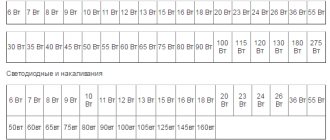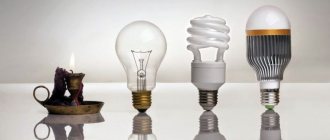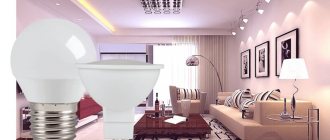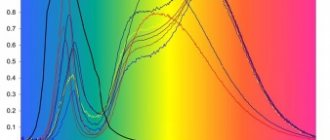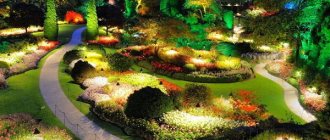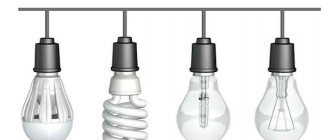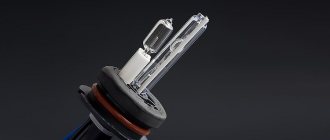For normal functioning of almost any aquarium, artificial lighting is required. Depending on the number of fish inhabiting the container, and especially plants, light of different quality is required. Gone are the days when the aquarium was illuminated with halogen lamps. Technical progress does not stand still, and now LED lamps are actively moving the usual fluorescent lamps from their place.
Due to their special properties, LED aquarium lamps are used not only as illumination, but also as the main source. This article will discuss various lighting options for aquariums, and also highlight the nuances of calculations when selecting LEDs.
Why LEDs
First of all, you should decide whether it is necessary to install LED aquarium lighting. Maybe this is a simple fashion trend and spending certain amounts of money imposed on the consumer? To understand this issue, it is enough to consider the benefits that can be obtained from using LED lighting:
- efficiency;
- better compliance with light parameters in comparison with fluorescent lamps;
- wide design possibilities;
- duration of operation;
- environmental friendliness;
- good mechanical protection against damage.
The main reason for the introduction of LEDs is, of course, economic. The fact is that with the same power, LED lamps emit many times more light. Therefore, the conventional lamp is replaced with a much less powerful LED lamp, which significantly saves the cost of lighting the aquarium.
The second important reason for using LEDs is to match the lighting parameters to natural light. Moreover, for specific cases, you can play with the parameters of the LEDs and choose options that are more necessary for the fastidious plants of the tropics.
The environmental component should not be ignored either. After all, LED aquarium lighting is harmless, since the material does not contain mercury compounds. In addition, the heating of LEDs is not as strong as compared to other lamps, and especially incandescent lamps.
Features of selection
Having decided on the installation of LEDs for the aquarium, before going to buy them, it is important to take into account the composition of the inhabitants. After all, if you keep mainly fish, then there is no special selection provided. Of course, you can set a goal and make lighting for a more advantageous appearance of the inhabitants of the underwater world. But basically, for an aquarium with fish, ordinary light is enough to make it convenient to view them.
It’s a completely different question if plants are bred in an aquarium. Especially if your plans include a “Dutch” aquarium with a large number of rare and whimsical plants. In these cases, lighting an aquarium with LED lamps requires preliminary calculations that take into account the spectral demands of the plants. In addition to the luminous flux parameter, which is measured in lumens, you will need to remember such as illumination in lux and light temperature in kelvin.
Types of LED lighting for aquariums
LED lighting for an aquarium can be designed in a variety of ways. Depending on the placement methods of LEDs, there are:
- LED strips;
- lamps;
- LED spotlights.
The use of this or that equipment will depend first of all on the contents of the aquarium, and then on its size. To a lesser extent, the design features of LEDs will be influenced by the shape of the aquarium and the presence and use of its lid.
If you have the opportunity to make LED aquarium lighting with your own hands, you should not miss it. In this case, in addition to saving on equipment, you can get an individually developed and implemented design. In addition to skills in working with electricity, you will need: a 12-volt power supply, wires and the actual LED lamps.
LED lamps for aquarium
Why LEDs?
What are the requirements for LEDs in an aquarium?
What types of aquarium LED lights are on sale?
The choice of LED aquarium lights on the market is not yet as large as, for example, fluorescent lamps. Most often in stores you can find low-power colored, usually blue, lamps that imitate moonlight. They are good in those aquariums where nocturnal fish live - with the help of night lighting you can observe them.
LEDs are widely available for lighting nanoaquariums; the most popular are small hanging lamps Aquael Leddy with a power of 3 and 6 W. There are similar lamps from Dennerle and Aqualighter, but they are on sale much less frequently, and Dennerle is also several times more expensive.
And only in the most advanced aquarium online stores can you find LED lamps for large aquariums. These are long Aquael Leddy (39 and 54 cm each), Aqualighter 1, 2 and 3 lines and Fluval LED lamps with adjustable length. They are designed to be mounted in the lid or on the walls of the aquarium, protected from water ingress, and very convenient to install and use.
As for the power of their lighting, according to aquarists, it is more than enough for good illumination of fish and decorations, but for Aman or Dutch aquariums with a large number of fancy plants, only the professional, very expensive Aqualighter 3 and Fluval LED models from the above models are suitable.
To be fair, let us mention another group of LED lamps, which are almost never found on sale in Russia. These are high-tech, powerful and incredibly expensive complexes for lighting marine reef aquariums from Hagen, Eheim, Giesemann.
LED homemade products
Since industrial LED aquarium lights are not yet very accessible, and the choice of ordinary LEDs in any electrical store is huge, many aquarists try to make lighting for their aquarium themselves.
For this, depending on the required lighting power, LED lamps, spotlights or strips are used. There are no established rules here; everyone experiments for their own pleasure, as well as to the extent of their skills and financial capabilities.
For example, we took the easiest and cheapest route and supplemented the fluorescent lighting of our aquarium with LED strips. Since we only needed to increase the light a little (the plants in this aquarium are unpretentious), we decided that such an upgrade would be enough.
The following materials and equipment were used:
- LED strip marked SMD 5050: heavy-duty diodes, white color, color temperature of about 6000 K, increased dust and moisture protection (silicone casing). Tape power 14.4 W per linear meter.
- Starter charger (its power must exceed the total power of the tape installed in the aquarium). In our case, a 60 W device was used for 3.5 meters of tape with a total power of 50.4 W.
- Aquarium silicone sealant.
A cover with tapes glued and attached to the power supply.
The length of the tape was measured according to the size of the lid so that it could be cut along the lines indicated on the tape. You cannot cut in other places! Cut the tape into the required number of pieces.
The ends of adjacent tapes were soldered with short pieces of wire, observing polarity (plus to plus) and soldered to the power supply. We made the wire to the block long enough so that the latter was located on the stand, outside the aquarium.
Then we glued the tape to the lid with silicone and pressed it with a weight until it dried completely (it could last up to a day, depending on the glue). The ends of the tape are sealed with silicone sealant.
And that’s it, after drying the cover is ready for installation.
Sealed connection between wire and tape.
The result of adding LEDs to fluorescent lamps immediately became visually noticeable - the aquarium brightened, in addition, the condition of the plants improved: they began to photosynthesize more actively (this can be seen from the oxygen bubbles on the leaves), grow faster and produce new shoots.
No unwanted side effects, such as overheating, were noted. The trigger device heats up to approximately 40°C, but since it is located outside the aquarium, this does not affect the water temperature in any way.
In a word, we were satisfied and are going to continue experiments in other aquariums.
Clearly, LED lighting is the future of the aquarium hobby. But there are already enough opportunities to appreciate its merits. Use them and see for yourself.
aquariumguide.ru>
LED bulbs
The simplest option for creating LED lighting in an aquarium is LED lamps. This is primarily suitable for small aquariums up to 50 l. Their covers often already contain sockets intended for conventional classic incandescent lamps with E27 and E14 sockets. For such options, all that remains is to select and purchase a light bulb of the required power and light temperature.
More expensive options will be ready-made rectangular-shaped LED panels of a certain length for ready-made aquariums of standard sizes. This LED aquarium light will be very easy to install. For example, you can look at equipment from the well-known company Aqualighter.
Main features of LED lamps
LEDs in aquariums as a type of lighting have recently been introduced into use, so there is no mass choice on the market.
But such lamps have a number of features:
- Economy is identified as a source of low energy consumption. At the same time, efficiency is at the highest level.
- LED aquarium lights do not heat up. There is no need to install a cooling system.
- The use of a reflector is not required, since all parts of the aquarium are illuminated evenly due to the direction of the light flux.
- Alternating diodes of different combinations when connecting allows you to achieve the desired spectrum.
- The duration of operation of the lamps does not affect the quality of the emitted spectrum.
- Long service life up to 60,000 hours. It depends on the working conditions.
LED spotlights
Aquarium lighting with LED spotlights is a very good option for open-top aquariums. An LED spotlight is a very bright light that can easily reach the bottom of an aquarium of any size and depth. Only one to three of them are required, depending on the size. For example, for a rectangular 100-liter aquarium, one 50 W spotlight or 2 x 25 W spotlights will be enough. In the case of the “Dutch” version of light, you need 1.5-2 times more light. That is, it is 1 spotlight at 100 W or 2 at 50 W.
Choosing the right lighting
LED strip, hermetically sealed in silicone, suitable for use on the bottom of an aquarium
Light in an aquarium plays a very important role, because when there is too much of it, or vice versa, not enough, the fish get sick and die. You should not assume that by placing the aquarium on the windowsill, the problem will be solved - rather, on the contrary, because the strength of sunlight is too great for a biosystem of this size. Therefore, it is best to choose the right artificial lighting, which in its effect will be similar to natural lighting.
The most common lighting for aquariums is LED and fluorescent. Despite the fact that for some time fluorescent lighting was very common, it is now being actively replaced by more modern LED lighting.
Interesting! An LED lamp produces a more natural spectrum of radiation, has the ability to adjust the brightness of the lighting throughout the day, and also consumes much less energy than other lamps.
The calculation of LED lighting for an aquarium is somewhat different, because the usual W/L calculation formula is not applicable in this case. Aquarists with experience determine the required level “by eye,” and for those who are just starting out, they recommend taking 10 lumens per liter as a conditional minimum lighting level (a lumen is the measurement of light flux). The only minor drawback of these lamps is their rather high price.
LED strips
Until recently, illuminating an aquarium with LED strip was only possible for small containers. Or it was used as a backlight for other types of lamps. This is explained by the fact that the first LED strips were made on ultra-bright first-generation SMD 3528 LEDs. Their luminous flux is only 5 lumens with a power of 0.1 W. Therefore, a 5-meter strip with 300 LEDs has a power of 30 W. For an aquarium with good plants, these 5 meters will only be enough for 30 liters, which is structurally difficult to implement.
Now there are strips containing more powerful LEDs of the new generation SMD 5050, SMD 5630 and SMD 5730. To illuminate most aquariums, including “Dutch” ones, SMD 5050 strips are already enough, which are only 2 times more powerful (0.2 W), and each emit 18 lumens of light. A 5-meter LED strip, including 300 of these LEDs, easily illuminates a 100-liter aquarium. And this is when used as main lighting.
SMD 5630 and SMD 5730 LEDs have a power of 0.5 W each and emit 40 and 55 lumens, respectively. When using them in lighting, it is necessary to consider cooling due to the stronger heating.
DIY aquarium lighting - video description
Advantages and disadvantages of different aquarium lighting options
Lighting selection
Spectrum and types of lamps
Blue light in an aquarium
Length of daylight
Plants and corals under aquarium lighting
Night illumination
DIY aquarium lighting with LED strip.
Lighting an aquarium with LED strip is one of the most energy-saving and, importantly, safe ways to illuminate an aquarium. Of all the types of LED aquarium lighting, the best is LED strip aquarium lighting.
The advantages of such lighting:
- LED strip is energy efficient; aquarium lighting with LED strip is the most economical type of lighting.
- This type of aquarium lighting is safe. The voltage of the power supply supplying the LED strip for the aquarium is 12 Volts, this voltage is safe not only for people but also for the flora and fauna of your aquarium.
- Adjusting the luminous flux. You can always increase or decrease the brightness of the lighting, so you can adjust any ice lighting for the aquarium.
- Can be used as additional lighting. A planted aquarium often requires additional aquarium lighting. An LED strip will make excellent LED lighting for an aquarium with plants with your own hands, both primary and additional.
- LED lighting of the aquarium in various colors. Although it is recommended to use white LED strips to illuminate an aquarium, this does not change the fact that in nature there are different colors and types of LED strips.
- Simplified installation. The LED strip is very easy to mount on the aquarium due to the adhesive base of the strip.
- The ability to mount an LED strip to illuminate an aquarium underwater, due to its tightness and IP65 protection class.
To make LED strip aquarium lighting with your own hands, you will need a 12 Volt power supply, 5 meters of LED strip (1 reel), strip power consumption of 9.5 Watts per meter.
In total, our lighting for the aquarium cost about 50 dollars, the price of one reel of tape with protection class IP65 is 25 dollars, the power supply is 20 dollars. Our aquarium required 2.2 meters of light strip.
We insulated the place where the LED strip was cut and connected to the power supply using transparent sealant, and glued it to the lid of the aquarium so that there was no contact with the water and the filtration system. As a result, we have an enviable aquarium with a filter and lighting. We used the rest of the tape stock to illuminate the computer system unit
STONES FOR AQUARIUM TYPES DESCRIPTION PHOTO DESIGN DESIGN VIDEO.
ROUND AQUARIUM - DESIGN CARE DESIGN PHOTO VIDEO.
WHAT IS AN AQUARIUM AND IS IT WORTH OWNING IT?
Advantages of LED aquarium lighting
Aquarium lighting with LEDs is a relatively new proposal. LEDs have important characteristics that make them leaders among lighting devices today. The use of such lamps has many advantages.
- They are very easy to install, due to the fact that the cartridges fit almost all types of bases.
- LED lamps are not afraid of water, therefore, the possibility of a short circuit is eliminated. At the same time, even in conditions of high humidity, these lighting devices function without interruption.
- LED lamps designed for aquarium lighting are fireproof.
- Such lamps do not emit heat during operation, which makes it possible to maintain a comfortable overall temperature of the aquarium, even if the lamps are on throughout the day.
- Depending on the length of daylight hours and the availability of natural light, you can change the brightness of the aquarium lighting yourself. In addition, it is possible to illuminate the aquarium at night and watch the life of the fish, admiring the amazing underwater pictures.
Important! The average operating time of one lamp is five years. Consequently, all this time there will be no need to replace components and there will be no need to disturb the inhabitants of the aquarium. In addition, it must be said about energy savings (about 70%). For these reasons, most aquarium owners prefer to light their aquariums using LED lamps. Special LED strips have the same qualities.
Safety and durability
Since LED lamps do not emit ultraviolet and infrared radiation, they are completely safe for absolutely all inhabitants of the aquarium. On the contrary, lighting an aquarium with LEDs has a beneficial effect on the color and health of fish. In addition, due to the spectral composition of the rays, they promote the development of aquarium plants. To ensure that the aquarium is illuminated as best as possible, you can combine different types of LED lamps. They can be installed in any conditions and in any premises.
aquarium-fish-home.ru>
LED lighting calculation
Calculation of LED lighting for an aquarium is made based on approximate standards for this type of tank. For example, it is assumed that 1 liter of aquarium water requires 0.5 W of lighting power and 40 Lm of luminous flux. At the same time, there are nuances, taking into account which the initial data can change significantly.
- An aquarium for breeding rare, fancy plants, the so-called Dutch one, requires a luminous flux of 0.8-1 W per liter of volume and a luminosity of 60 or more lumens per liter.
- Aquariums with elongated shapes and significant depth also require brighter lighting, which is selected individually. It is approximately believed that with every 10 cm of depth, the luminous flux decreases by 50%.
You should also remember that if the lighting is incorrectly selected, there can be two main options. If there is a lack of light, the plants will wither and produce oxygen poorly, which, in turn, can have a detrimental effect on the fish. In the case of excess light flux, rapid growth of both plants and simple algae can be observed. Externally, this can manifest itself in cloudy water and overgrowing of the walls of the aquarium. This is especially bad for new tanks, when the main plants are just growing and have no vigor. In this case, the simplest algae grow much faster.
How much light do you need? Calculation of LED aquarium lighting
Calculating the number of LEDs must begin by calculating its area.
If your aquarium depth is less than its length and width, you can neglect the loss of light in the water column, and make calculations with a margin of 1.3-1.8 times. Let's say we have a capacity of 1x0.6x0.4 m, which gives us a volume of 240 liters, and the illuminated surface area is 6000 cm2 or 0.6 m2.
Required illumination (from the directory):
- If the aquarium contains mainly fish, 3000-6000 Lux is enough;
- 6000-10000Lx for algae and fish;
- 10000-15000Lx is needed for herbaceous and bright plants.
The exact values of the required illumination for specific types of fish/plants can be found in modern directories of aquarium flora and fauna.
Chinese LEDs from the lower price segment produce from 80 to 100 Lm/W, expensive LEDs from well-known brands (OSRAM, Philips, etc.) up to 140 Lm/W.
Let us remind you that 1 Lux = 1 Lumen / 1 m2.
E = F / S, where E is the illumination Lx, F is the luminous flux Lm, S is the area m2.
Let's apply the formula. Let's express the luminous flux:
F=E*S
Let’s take as an example the required illumination of 10,000 Lux; we calculated the area to be 0.6 m2.
F = 10000 * 0.6 = 6000Lm
The propagation of light and the change in brightness with distance are affected by the inverse square law. Those. with an increase in distance by TWO times, the illumination will drop by FOUR times, and this is provided that the environment is transparent, not smoked or dusty.
6000Lm is the required luminous flux, provided that light passes through clean air at a distance of 1 meter. In our country, water is a denser medium, so the light flux should be several times stronger. On the other hand, the depth (distance from the lamp to the bottom) is almost half the calculated one (1 m) and the luminous flux (according to the inverse square rule) at this distance will be 4 times stronger. Therefore, these two indicators exclude each other and do not affect the result.
Now you need to select LEDs for the aquarium based on their spectral composition. Take a look at the chart:
Choosing LED power for an aquarium
Photosynthesis is affected by red and blue colors.
As a basis, we will choose a white ribbon 5730 60 pcs/m, its luminous flux is about 2000 Lm/m, and its power is 14.4 W/m. This means we need about 2.5 meters of such tape, this will be more than 5000 lm. Let's add red and blue LEDs 5050 30pcs/m, 2 meters of each color. The luminous flux of each is about 300 Lm/m, power 7 W/m. In total it turns out 2.5 * 2000 + 4 * 300 = 6200 Lm, which is already enough.
When lighting with discrete LEDs, the technique is the same: divide the required luminous flux by the luminous flux of one diode and get the required number of discrete LEDs.
Power supply power:
(14.4 * 2.5 + 4 * 7) * 1.25 = 80 W
This is with a decent margin of a quarter of the power.
Which brand of LED strip should I choose for my aquarium? It doesn’t matter, you just need to take into account important rules:
- Remember about the dust and moisture protection class. When the tape is immersed in water - IP68, when installed on the inside of the lid above the water of the aquarium - IP65;
- cheap Chinese tapes always overestimate the real luminous flux indicators. Take them only if you are on a limited budget and as a temporary solution;
- give preference to proven manufacturers such as Philips or Osram. The high price is compensated by high performance and service life.
How to count incorrectly
Everywhere on the Internet you can find calculations of illumination based on the volume of the aquarium in liters. This is a fundamentally wrong approach. The W/L figures were derived empirically and were previously only used for incandescent lamps. Today, the luminous flux of LEDs is an order of magnitude stronger than the luminous flux of incandescent lamps, at similar powers (W).
For example, it is often recommended to use a ratio of 0.9-1W/L. Those. with our estimated volume of 240 liters, we need a light source with a power of 216-240 W. And this is 3 times (!!!) more than necessary. Be careful and don't make this mistake.
With your own hands
There are several ways to install LED lighting for an aquarium with plants. Let's look at the most popular lighting options using LED strips. For example, let's take a 100-liter aquarium and a 5-meter LED strip, including 300 SMD 5050 LEDs of 0.2 W each. Taking it as a fact that for the natural development of plants, the light flux is best directed from top to bottom, let's consider several options.
- We place the LED strip on the top cover of the aquarium in the form of a snake. The rings can be placed in any direction, but the density of the LEDs must be uniform. Then the tape is glued with a special silicone glue that is not afraid of moisture. If the kit already includes a starting device with a power supply, then we simply place it on the outside for better heat transfer. If there is no starter, you must either purchase it separately or construct it from a computer power supply. At this point the work is considered completed.
- In the second option, the LED strip is wound on a cylindrical profile in the form of a fluorescent lamp. The result is a neat cylindrical LED lamp. If necessary, you can take two cylindrical lamps from one LED strip. Of course, the result is not professional LED aquarium lighting, but such lamps will perform their main functions well.
- If you have blanks and forms from the LED strip, you can make a figure of any configuration. The volumetric chandelier (or several chandeliers) obtained in this way is attached in any convenient way either to the lid of the aquarium, or to special brackets in the walls if the aquarium is open.
Why is it better to light an aquarium with LEDs?
Due to the huge diversity of living creatures and greenery in a reservoir, it is necessary to “adjust” and sometimes use not one, but several different light sources to preserve all species, with the help of which you can extend the length of the day.
Some aquarists use LED spotlights, while others prefer conventional lamps. Still others use halogens or good fluorescent lamps, while others choose LED strips in the aquarium.
In theory, a normal light source:
- It must emit rays in many spectral ranges at once, so that all plants (both lower and higher) grow and do not bloom. If you use, for example, ordinary lamps that have only a yellow spectrum, then higher plants may wither, and because of this, the water will quickly bloom.
- Do not heat the water. A lamp installed in close proximity to any home water area warms it up, at least a little. Many fish cannot tolerate an increase in the temperature of the surrounding fluid by more than 2°C and may die.
Let's consider all the options and find out which lamps are more profitable to use:
- Halogens are a good and economical source of luminous flux. They provide excellent light and do not emit much heat. But they are more expensive than regular ones.
- A simple light bulb is a popular type of lighting for a mini-reservoir. But it only produces yellow light, which is unacceptable for higher plants. Such a lamp has a high heat output, and if it is located close to the aquarium, living creatures can die due to incorrect temperature conditions. To eliminate heat, you can use ice by throwing it into water in cellophane bags.
- Luminescent samples were the most popular among aquarists. They are economical, durable, have a wide spectrum and diffused light. Just a pair of such lamps can fully illuminate a 400 liter pond. The spectrum produced depends on the gas inside them. But they are dangerous due to the presence of mercury vapor in the cylinder.
- LED lights for a planted aquarium are the best option. Their low heat transfer and high efficiency are known to everyone. They are environmentally friendly and harmless to any inhabitant of the home depths. Their range is limitless.
- LED strip is a little worse than the previous option. Sometimes you have to search for a long time for a suitable assortment. Many tapes have low light output, and if bright ones are not available, you have to increase their quantity.
How to easily choose LED lighting
To easily select LED equipment, follow the following plan:
- decide on the contents and inhabitants of the aquarium;
- taking into account all the parameters, make a calculation based on the standard of 0.5 W per liter;
- decide whether the lighting will be made with your own hands or purchased ready-made;
- knowing the power of the luminous flux and the configuration of the aquarium, choose the design of LED lighting - lamps, lamps, strips or spotlights;
- select the required amount of equipment;
- install a ready-made LED lamp for an aquarium or assemble it from selected components.
For those wishing to install LED lighting underwater, remember that you need to choose equipment with protection class IP 68. While the standard IP 65 design implies only short-term splashing, but no more.
Assembling the lamp with your own hands
When installing a lighting system for an aquarium with plants, you must immediately decide on the type of lamp. The most popular and simplest is the use of LED strips, for example, for a standard 100 liter aquarium, a five-meter strip with SMD 5050 diodes, the power of which is 0.2 W, is enough.
The tape is attached to the lid of the aquarium in the form of a snake, and the direction may be different, but it is very important to maintain the same density of LEDs. The lamp must be fixed using silicone glue; the starting device and power supply must be placed only on the outside to ensure proper heat exchange and prevent moisture from entering them.
The second method is more difficult, it requires certain skills, but the result is worth it. To do this, instead of a standard lid, a diamond-shaped or rectangular lamp is installed above the aquarium, providing lighting with a brightness of 10,000 lm and a power of 120 W. This lamp is quite enough for an aquarium with a volume of 200-300 liters.
The technical characteristics of such a lamp will be in no way inferior to ready-made factory ones, but their cost will be much lower. To assemble, you will need about 40 LED lamps of 3 W each, colors - white, blue, red, you need to be careful with green, as it can provoke accelerated growth of algae. It would be wrong to completely exclude green diodes, but constant monitoring of the balance is required to prevent the growth of an unfavorable environment.
It is best to take foreign-made llamas from brands such as Osram and Philips, although Era, Feron, and Gauss are also excellent. To assemble a lamp for an aquarium with a volume of 200-300 liters you will need:
- LED strip, LED lamps;
- a plastic gutter with a length of 2 meters and a width of 10 cm (the length will depend on the dimensions of the aquarium itself);
- 12 V power supply, it is possible to connect the lighting to a desktop computer;
- wire with a cross section of 1.5 mm;
- air conditioner 6-12 V;
- connectors for lamps (40 pieces, according to the number of lamps, connectors are not needed for the tape);
- tool for cutting holes 48 mm.
Aquarium lighting made from LED strip
You need to start by preparing the base - two gutters and holes are cut in a checkerboard pattern in the plastic structure. LEDs will be inserted into these holes, which are very important to securely fasten. All lamps are connected with a soft wire, and then connected to the power supply. The fan is placed on the heated area from the outside of the structure.
If only white lamps are used for the lamp, then the ribbon should be blue to imitate moonlight. It is mounted on the back wall and can be turned on only at night or in combination with white light, ensuring coverage of the required spectrum.
In general, when calculating LED lamps, you need to focus on the following indicators - 0.5 W per liter of water, if the aquarium is very deep, then take a 1 W lamp per liter. The purpose of the aquarium is also taken into account, for example, a herbalist needs bright, good lighting, without which photosynthesis will simply be impossible.
In addition, when choosing lighting, you need to take into account the spectrum and color temperature. For plants and aquarium inhabitants of different species, they can be completely different. The level of illumination should be uniform, daily changes in light are necessary to ensure the health of your pets.
Selecting a manufacturer of LED elements
Aquarium lighting with LED lamps is becoming increasingly popular. Today, LED lighting is offered by several companies:
- Aqua Med.
- Aquael.
- Hagen.
- Juwel.
- Sera.
- Dennerle.
In addition to those officially existing, there is a huge list of companies from China where LED products can be purchased for a lower amount. In this case, you will have to check the quality yourself. But one thing is known for sure: the parameters of Chinese LEDs differ by an order of magnitude to a lesser extent. That is, if the luminosity of European and Japanese LEDs corresponds to the parameters, then the Chinese ones will shine weaker.
